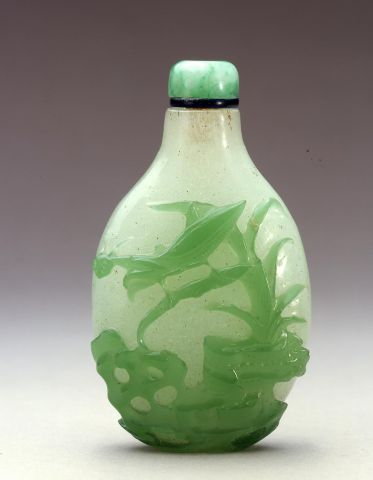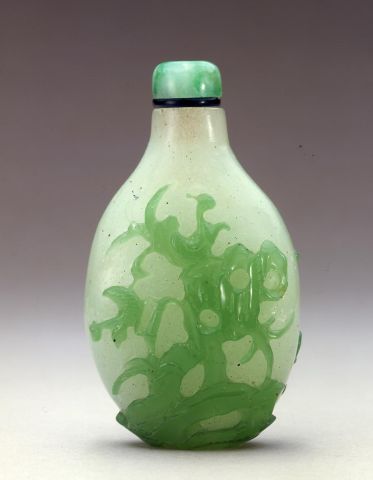

Bottle ID: 00144
SNOWFLAKE W/LIME GREEN OVERLAY, INSECTS
Date: 1750-1850
Height: 63 mm
Glass, of flattened ovoid form with sloping shoulders, overlaid with lime-green on an opaque bubbly ground and carved with on one side, a large rock with two praying mantis perched on leafy branches, the reverse with a praying mantis perched on a banana plant issuing from craggy rocks; the base encircled by pierced rockwork and with an indented oval foot.
Possibly attributed to the Suzhou School.
Similar Examples:
Hall, Robert. Chinese Snuff Bottles II, 1989, p. 129, no. 109.
Provenance:
Clare Lawrence Ltd.
Joseph Baruch Silver
Richerson Rhodes, New Orleans, Coll. no. 54
Norton Simon Museum of Art, California
Exhibited:
Annual Convention ICSBS Toronto, October 2007
Honolulu Academy of Arts, Honolulu, Hawaii, November 23, 1989 - January 7, 1990
Israel Museum, Jerusalem, Israel, December 15, 1987 - June 25, 1988
Published:
Chinese Snuffbottles from the Collection of Joseph Baruch Silver, in Conjunction with the Exhibition at the Israel Museum, Jerusalem, Winter 1987, p. 19, no. 24
An article in the Journal of the ICSBS, Autumn, 1995 by the present author discusses the stylistic similarities between the Suzhou School of carving, of predominately jade and hardstone bottles, and the Yangzhou School of glass bottles emphasizing the cross-fertilization of ideas between the two geographically close Schools. The bottle above, although of overlay glass, has been given a tentative attribution to the Suzhou School based on the manner and style of the carving. One of the characteristics of the Suzhou School was the sculptural quality of the carving, giving a three dimensional appearance to the overlay color. On this bottle the treatment of the rockwork is consistent with Suzhou School carving with both serrated and convoluted pierced rocks in evidence. The overall design of a naturalistic subject matter is continually seen on bottles of the Suzhou School while bottles made either in the Palace Workshops or in the glass workshops in Beijing tend to exhibit more formal subjects related to the Court, such as dragons.
Suzhou was renowned as the center of the best lapidary work in jade and it is entirely possible that a carver may have tried his hand at the carving of a glass bottle. From the Archives of the Palace Museum, there is a list of artisans who worked in the Palace glasshouse. In the different workshops of the Zaobanchu, the workforce came from three distinct groups; the majority being servants and craftsman from Banner-men of the upper three Banners, (under the control of the Emperor), secondly from the South (retained by the Provincial Governors and the Silk Manufactories), and thirdly provincial artisans specially recruited. The numbers of workers of all three groups varied, reaching a height of 837 at the end of the eighteenth century and then gradually decreasing during the nineteenth century to 432 in 1910 as the Qing dynasty collapsed. In the glasshouse, in addition to "glass-men" and "glass-blowers", there were other artisans working. A very useful list of artisans for the year 1799 (4th year of Jiaqing) provides an interesting picture of the organization of the glasshouse.
In addition to the above two mentioned types of workers there were "jade workers, throwers, builders, scrapers, carpenters, filers and sulai-attendants". The jade workers, throwers, scrapers and filers all used a lathe following the tradition of jade lapidary techniques, providing a higher level of finish to the glass blanks coming from their co-workers. Zhang Rong of the Palace Museum concludes from the records that in all likelihood these artisans who were employed in the grinding rooms of the glasshouse came from Suzhou or that they were second generation artisans trained by Suzhou jade carvers at the Palace Workshops. Despite the fact that this documentation refers only to the Palace Workshops, it shows that jade workers did participate in the production of glass objects to some degree and that they may have come from the very area where the style of carving of this bottle can be traced. Very few other glass bottles attributable to the Suzhou School have been identified and it is likely that the workshops did not take up the carving of glass with any regularity.

 English
English 中文
中文